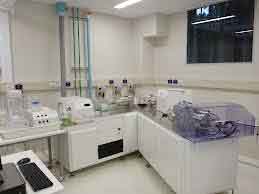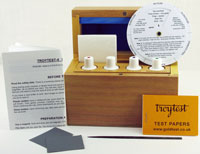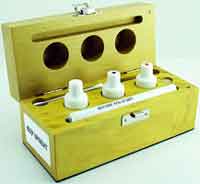Touch-acid testing at the Birmingham Assay Office
Methods of testing gold (including advanced methods) used at the Birmingham Assay Office
CONTENTS
ACID TESTING (AND OTHER METHODS)
FILING OR SCRAPING?
TOUCHSTONE TESTING
ICP TESTING
FIRE ASSAY TESTING
XRF TESTING
OTHER TESTING
PRODUCTS
ACID TESTING (AND OTHER METHODS)
- Buy chemical testing sets
- Also refill bottles
- See the latest electronic gold tester by Kee.
- There is also a very good book on the subject.
The methods listed below are those used at the Birmingham Assay Office. There are many more methods of testing precious metals, see our main article Ten ways to test gold, silver and platinum.
We visited the Birmingham Assay office for their special training course for touch acid testing.
They started by explaining that to test the fineness (carat) of precious metals for the purpose of hallmarking, they uses XRF and the Referee Cupellation (explained below). Both of these methods are very accurate. But before they do this, they use the touch acid testing method, to give an approximate indication of fineness. All these are advanced methods. For the average retailer they recommend the Troytest-4 acid set, and most of the course was about how to use this.
After half an hour of theory (going through the instructions) we had a long practical session, testing dozens of samples. This was interesting. When we manufacture the testing sets here at Quicktest, we check the acids against a dozen known samples. On the course, we had the opportunity to test the acids against 45 known samples.
The Birmingham Assay Office hallmarks between five and six million items per year, most of which are tested. And so we were curious to know how they used acids for testing gold, explained below. Also below are some of the more advanced techniques they they used
FILING OR SCRAPING?
THE PRINCIPLE: if an item is gold plated and you test the surface, you will, quite correctly, get a 'gold' reading - because the surface is gold. So you must file / scrap the surface so that you are testing whatever might be underneath.
OUR METHOD: We give away a fine needle-file with each set, you can file thoroughly over a very small area, which causes the minimum of damage.
ASSAY OFFICE METHOD: they remove the surface with a 'scraper' - a three-edged steel tool (the edges of the scraper are sharp, it's used like a potato peeler). Because they are scraping a relatively large area (unlike using a fine needle file) there is no resulting 'notch', it's much 'gentler', in skilled hands you can hardly see that the item has been 'scratched' *. The downside is that it takes practice to use, it's not as easy a needle file. We were impressed, we now stock scrapers.
* This is the origin of the expression, "to come up to scratch".
TOUCHSTONE TESTING

THE PRINCIPLE: streak (scrape) the item firmly across a special stone (touchstone) so that that it leaves a streak of gold, place the acid over the streak of gold on the stone instead of directly onto the item NOTE: it is not true that using a touchstone means you don't have to remove the surface before testing!
OUR METHOD: scrape an area of the test-item very firmly across the touchstone a few times, this is to be certain you are removing any plating. Wash the item and touchstone clean. Now you can streak (scrape) the cleaned area horizontally across the stone. Then streak (scrape) the known samples from the set of six test-needles across the stone, to make parallel streaks below the unknown streak. Place the 9ct acid vertically across all the steaks, watch to see how quickly they dissolve, if the unknown streak dissolves at the same speak as one of the known streak, then your item is about 9ct. If none of the streaks dissolve, repeat the process with the 18-24ct acid, he unknow streak will dissolve at the same speed as one of the known streaks, indicating the carat.
ASSAY OFFICE METHOD: the method is the same as above but instead of one set of 6 test-needles they have 12 sets. Each set is a lightly different colour and each set contains 10 different carats. The user selects a set that best matches the colour of the unknown item. An inexperienced user will make 10 streaks but, with experience, they get more accurate at 'guessing' which carats to use - which reduces the time taken to carry out a test from several minutes to five minutes. The woman in the photo is the apprentice, she has been doing the job for six months and is making good progress.
CONCLUSION: customers ask, "Is it easy to use a touchstone?", Our touchstone method (above) is 'easy' if you work very slowly and carefully and follow the instructions precisely. What we learnt at the Birmingham Assay office is that the apprentice has been following their method for six months and is, under strict supervision, making good progress. Our recommendation for testing jewellery for retail / scrap-buying: use our method (no touchstone), it's simpler.

ICP TESTING
ICP is inductively coupled plasma mass spectrometry.
A tiny sample is removed, weighed and dissolved into the appropriate solution. The solution is then sprayed through an ultra hot flame where until it is destroyed in a burst of plasma and the resulting spectrum is analysed. This is the most accurate method of analysing precious metals to discover their exact chemical composition.
As you see from the pictures, these are not 'testing machines', these are laboratories and cost tens of thousands of pounds.
FIRE ASSAY TESTING
This is the referee method of assaying gold alloys. A small gold sample is weighed, silver added, and then wrapped in a lead envelope. The sample is melted at 1200C in a cupel. This drives off the base metals and leaves a ball of fine silver and gold. The ball is flattened and put into acid to dissolve the silver away, leaving a "cornet" of pure (24ct) gold. Then it's weighed again and the carat (percentage of pure gold) is calculated. Each test takes two and a half hours.
XRF TESTING
XRF is x-ray fluorescence, those who can't remember "XRF" say, "the x-ray machines".

XRF (cabinet). This is an example of a 'cabinet style' XRF tester but not one used by the Birmingham Assay Office. The Birmingham Assay Office's XRF instruments cost £50,000.00 each [that was a few years ago, today you can get small versions for as little as £15,000.00]. As with ICP (see above) it gives a detailed analysis of the chemical composition but, unlike ICP, it is totally non-contact. However, it will not usually test through plating (the best clue to plated items is inconsistent or unexpected readings) so you still have to file the item first.

XRF (handheld). Scrap dealers and antiques traders tend to use these 'cheap' XRF machines (handheld 'scanner' type), which you can now get find for as little as £10,000.00 (these are not used by the Birmingham Assay Office).
Experienced users acknowledge that, even with these, care must be taken to ensure you are not testing surface plating (or rolled gold) or you will get incorrect readings.
OTHER TESTING
OTHER METHODS OF TESTING. The methods listed above are those used at the Birmingham Assay Office. There are many more methods of testing precious metals, see our main article Ten ways to test gold, silver and platinum.
OTHER TESTING SERVICES AT THE BIRMINGHAM ASSAY OFFICE. It is not only the testing of precious metals that takes place at the Birmingham Assay Office, they test for nickel (high levels on nickel can trigger allergies, especially jewellery used for piercings); they test for lead (not found in precious metals but it used to be common in paints and in children's toys); they test for cadmium (in production, molten cadmium is very toxic); they mainly test costume jewellery, toys and fabrics, further information.
PRODUCTS
RELATED ARTICLES






